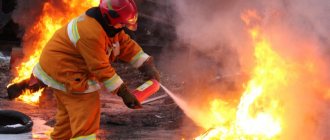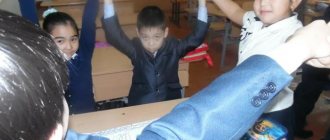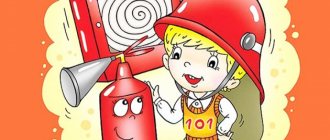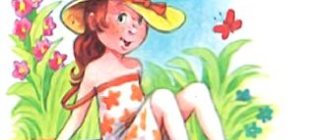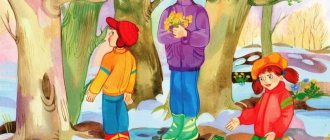- Home /
- “Safe summer” preventive measures /
- Posts /
- Road safety /
- “Safe summer” preventive measures
06/07/2021 As part of the “Safe Summer” campaign in kindergarten, teachers hold conversations, safety minutes, and didactic games on traffic rules with children in all age groups.
Street
A road that runs through a city or town is called a street. It has a roadway along which cars move. Sometimes the roadway is divided by a strip of green space - a boulevard into two parts, two lanes.
Along the edges of the roadway there are strips covered with asphalt - these are sidewalks. Pedestrians move along them. The sidewalk rises slightly above the roadway; This is done in order to clearly define the boundary between the roadway and the sidewalk.
On some streets, where there are especially many pedestrians, the sidewalk is fenced off from the roadway with metal barriers - they prevent pedestrians from unexpectedly entering the roadway, which is very dangerous. No pedestrians have the right to climb over the fence.
Streets on the roadway of which cars move in two directions: on one side in one direction, and on the other in the opposite direction, are called two-way streets. Streets where traffic flows in one direction are called one-way streets.
There are streets that run parallel to each other, and there are streets that intersect. The place where they intersect is called an intersection.
- What is a street?
- Where should a pedestrian walk?
- Is it possible to climb over metal sidewalk barriers to cross the street?
- In which direction do cars move on a two-way street?
- What is the name of the intersection of streets?
We are pedestrians
A pedestrian
All people who move along the street on foot (persons driving a bicycle are considered the same) are called pedestrians.
Most of the traffic on streets and roads is pedestrians. Even drivers, when they get out of their cars, for some time join the great army of pedestrians. For many centuries, pedestrians were left to their own devices to determine the safety of pedestrians and establish traffic rules for them. Now they have been introduced in all countries of the world, every pedestrian, young and old, must know them. Repeat with children.
Basic rules for pedestrians.
- Pedestrians must move along the roadway on sidewalks or pedestrian paths.
- Walk only on the right side of the sidewalk.
- If you meet an acquaintance, then in order to talk, step aside with him.
- If you are walking with your friends, then do not block the road, lining up in a line of 3-4 people.
- When waiting to cross, never stand on the edge of the sidewalk.
- You need to cross the street in places where there is a pedestrian path.
- You need to cross the road when the traffic light is green, only after you are sure that the cars have time to brake and stop.
- Do not cross the roadway diagonally, but only strictly straight.
- Before crossing the road, you need to look left, right and make sure that the transport is far enough to cross the road.
- Small children are held by the hand when crossing the street.
- When moving along the crossing, you must be careful, without stopping, without interfering with other pedestrians, and without sticking to the right side.
- You need to wait for route transport at specially equipped places - stops.
- Do not push passers-by when rushing to the bus.
- You cannot play next to or on the roadway.
- You cannot go out onto the road because of stopped vehicles or because of bushes.
- You cannot suddenly appear in front of nearby traffic.
- Always remember that not only your life, but also the safety of others depends on your behavior on the street.
- What do you call people walking along the street?
- Who is the sidewalk for?
- Which side of the sidewalk can you walk on? Why?
- Where are pedestrians required to cross the street diagonally?
- Where should I wait for shuttle transport?
- Why can’t you suddenly appear in front of nearby traffic?
- Why can't I play next to or on the roadway?
We and transport.
Transport
The word “transport” was introduced into the Russian language by Tsar Peter the Great. When he compiled the first Russian Maritime Charter (rules for military sailors) in 1720, he called ships for transporting goods “transports.” The king borrowed this word from the German language. And the Germans took it a long time ago from Latin, which was spoken by the ancient Romans. It meant “to carry”, “to move”. The word quickly took root among us; no one considers it foreign anymore. True, its meaning has changed over time. We now call transport not only cargo ships, but also other equipment for transporting goods and passengers.
Transport can be water, air, land (rail, road). We see cars, buses, and trucks on the streets every day. And we don’t just see - we cross the roads along which they rush, we drive in them. When people travel in transport, they are called passengers. Repeat with children.
Basic rules for passengers.
- You need to wait for route transport at specially equipped places - stops.
- When you are waiting for transport, do not stand on the very edge of the sidewalk: you can trip or slip in winter and get hit by a wheel.
- Enter and exit public transport from the front.
- While driving, you cannot touch the doors with your hands until the driver opens them.
- When you enter, do not forget about those who come after you, behave correctly and calmly.
- If you are sitting, give your seat to someone older than you. Boys always give way to girls.
- Don't forget that there are passengers standing and sitting around you. Don't scream when talking to a friend, don't laugh loudly, don't wave your arms, don't stand on the seat with your feet, don't chew ice cream or pies - you can dirty those around you.
- While driving, do not get up from your seat or move around the bus. If you make a sharp turn or stop suddenly, you may fall and get hurt.
- Don't stick your head or hand out of the window. Passing traffic may hit you, causing serious injury.
- You cannot talk or distract the driver while driving.
- After getting off the bus, you need to go to the pedestrian crossing and only cross the street there.
Ask the children:
- What types of transport do you know?
- Why can't you stand on the edge of the sidewalk when you're waiting for transport?
- Where do you expect shuttle buses?
- Is it possible to talk to the driver while driving?
- Is it allowed to walk on the bus while it is moving?
- Why can't you put your feet on the seat?
- Is it possible to talk loudly, shout, wave your arms, or eat ice cream on the bus? Is it possible to touch the doors of a bus while it is moving?
Rules of behavior during seasonal weather changes.
Attention! Winter came…
Snow fell and everything around changed. And trees, and houses, and roads. Everyone rejoices at the coming of winter. You can play snowballs, make a snow woman, go sledding and skiing.
Frost and sun - a wonderful day! But …
- In winter, there is a danger of injury due to ice. Therefore, you need to step on your entire foot, walking in small steps, slowly, with your legs slightly relaxed at the knees.
- The roads have become slippery, you need to be careful when crossing them - you can fall.
- It is difficult for the driver to stop the car, and with sharp braking it can skid onto the sidewalk.
- When it snows, raised collars, large hoods that cover the face, foggy glasses, a hat pulled down too far, a collar that is too high - all this hinders traffic and prevents pedestrians from inspecting the road. Because of this, you may not notice an approaching car.
- The car windows are covered with snow and the driver has difficulty seeing pedestrians and traffic lights.
- Do not play in the snow on the sidewalks, roadways, or roads.
- Do not sled, ski or skate on sidewalks, near or on roads.
- Don't cling to the bumper of a passing car. Not only your life, but also the safety of others depends on your behavior on the street.
- What precautions should be taken during icy conditions?
- Why is it difficult for a driver to stop a car?
- Where should you play, ski and sled?
- Why can't you cling to the bumper of a car?
MAGAZINE Preschooler.RF
Entertainment according to traffic rules for children 3-4 years old “Toropyzhka cyclist”Module: child cyclist
Program: “The ABCs of Traffic”
Tasks:
- Educational: continue to reinforce the rules of behavior on the roadway; fix the road signs “Pedestrian and bicycle path with traffic separation” , “End of pedestrian and bicycle path with traffic separation” ; to form in children a desire to comply with traffic rules and a sense of responsibility in observing traffic rules.
- Developmental: develop agility, speed, endurance, ability to adapt to changing conditions; develop spatial organization of movements; activate the processes of thinking, attention and speech of children.
- Educational: cultivate friendly relationships between children; educate children to be competent pedestrians.
Corrective tasks: to promote the development of dynamic balance, spatial orientation, eye, dexterity, endurance.
Vocabulary work: cyclist, bike path, pedestrian, road sign, sidewalk; yard, bicycle, scooter; consolidate the names of road signs in speech.
Equipment: scooters, bicycle, ball, road signs “Pedestrian and bicycle path with traffic separation” , “End of pedestrian and bicycle path with traffic separation” , large signal cone, 2 baskets, small balls according to the number of children.
Preliminary work:
- Didactic games “Assemble a bicycle” , “What is extra” , “Find the shadow” .
- Watching the cartoon “Road Traps. Bike" .
- Reading A. Usachev “Road Rules in Poems” .
Progress of entertainment:
Educator: Guys, we live in a big, beautiful city, where there are a lot of people, cars, and roads. Our kindergarten is located next to a big road. There is a lot of traffic on it. Do you think it’s dangerous on the streets of a big city? (answers). Why? Maybe we should stay at home? (answers). Drivers and pedestrians need to be especially disciplined and attentive. Everyone should know and strictly follow the traffic rules, both adults and children. If a person knows and follows the traffic rules, then he is not in any danger.
Toropyzhka enters the race track on a bicycle.
Toropyzhka: Oh! Hello kids, girls and boys! Why are you sitting here? Get ready quickly and come with me to ride bicycles, ride scooters and play ball!
Educator: Hello, Toropyzhka, where are you going to ride your bike?
Toropyzhka: Like where? Of course, on the street, there are so many smooth and level roads that you can accelerate on a bicycle and fly like a rocket, overtaking buses.
Educator: Are you saying that you ride a bicycle right along the road?
Toropyzhka: That’s funny! Where should you ride a bike? By the lake?
Educator: Guys, it seems to me that Toropyzhka does not know the rules of the road at all, and he is very lucky that he came to us without getting into trouble on the road.
Toropyzhka: Rules? What are the rules? Should you wash your hands before driving? (laughs)
Educator: Guys, let's tell our guest where you can ride bicycles and scooters (on the bike path, you can't go from the yard onto the roadway). Our kindergarten has just such a special bicycle path. We invite you, Toropyzhka, to ride along our path with the guys and even compete to see who will be the fastest, most dexterous, and brave.
Toropyzhka: Great! Show me your bike path soon.
Toropyzhka and her children approach the bike path.
Toropyzhka: Wow! Disperse! Now I'll ride with the breeze! (Toropyzhka rides her bike like a snake: sometimes along the dividing strip (in the middle of the road), sometimes along the pedestrian path).
Educator: Hurry up, wait, where are you in a hurry? You broke the rules again.
Toropyzhka: What other rules are there? Well, here I am riding along the bike path, I remember everything.
Educator: Look, there is a sign here that divides the pedestrian and bicycle paths into two halves. On this side (the teacher shows), who can move, children? (pedestrians), but on this one? (shows). That's right, here you can ride a bicycle and scooter. And the sign ahead with a crossed out red stripe tells us what, children? (answers). Now do you remember everything, our friend?
Toropyzhka: Now I remember everything for sure. It’s great that I ended up in your kindergarten! I learned so many new and useful things.
Educator: Well, if you remember all the rules, then I suggest you play with our guys on scooters. Is everyone ready to show dexterity and speed? But first I suggest you do a warm-up.
A warm-up is carried out to develop orientation in the surrounding space with the involvement of vision and hearing (poems by S. Mikhalkov).
I roll on two wheels, (They go in a circle, one after another.)
I turn two pedals, (They walk, raising their knees high.)
I hold on to the steering wheel, look forward, (Hold an imaginary steering wheel with their hands.)
I know: the turn is coming soon. (They turn and go the other way.)
Games for preschoolers on scooters to develop dynamic balance, spatial orientation, eye, dexterity, and endurance.
"The fastest scooter"
Progress of the game: Children line up in a column. At a signal, preschoolers are asked to ride a scooter to a landmark (a large signal cone), ride around the cone, and return in a straight line to their team.
"Hit the target"
Progress of the game: A team member rides a scooter in a straight line and reaches the cone. There is a basket with balls near the cone. One meter from the basket there is an empty basket. The participant gets up from the scooter, takes a ball from the basket and throws it into an empty basket. After the throw, he gets on the scooter and returns to his team, passing the baton to the next participant.
Educator: Well done, guys, today we taught Toropyzhka where you can ride a bicycle without interfering with pedestrians and without violating traffic rules.
Toropyzhka: Thank you very much, guys, I learned and remembered a lot, and now I will definitely follow the traffic rules, because these are my rules too. Thank you very much, goodbye! (leaves on a bicycle).
Educator: There are no worries
For those who don't play on the road!
This is where our fun ends. See you again!
| Next > |
Rules of conduct during seasonal weather changes
On a cloudy rainy day
the danger for drivers and pedestrians increases. In such weather, drivers have difficulty seeing pedestrians and pedestrians have difficulty seeing whether a car is standing or moving.
When it rains, you need to be very careful, as the road becomes wet and slippery, and you can fall. And it's hard for the car to brake.
When it rains, water flows down the car window, the mud-splattered windows impair visibility, so the driver has difficulty seeing people and traffic lights. Yes, and umbrellas, large hoods that cover the face, foggy glasses, a hat pulled down too far, a collar that is too high - all this hinders traffic and prevents pedestrians from inspecting the road. Because of this, you may not notice an approaching car.
You have to be very careful!
Look carefully and slowly cross the road!
- Why should you be especially careful when crossing the road in the rain?
- Why is it difficult for a driver to see the road and traffic lights in rainy weather?
- Why is it difficult for a driver to brake in rainy weather?
- What prevents pedestrians from inspecting the road when it rains?
Crossroads
An intersection is a place where streets intersect. Depending on the number of intersecting streets and the angle of their intersection, intersections are: four-way (cross-shaped and X-shaped), three-way (T-shaped and U-shaped), multi-way (from which more than 4 streets depart)
Each intersection has its own boundaries; to determine them, you need to mentally connect the corners of the houses facing the intersection. The part of the street located between two intersections is called a block.
An intersection that occupies a large area and where several streets intersect or originate is called a square.
Intersections can be regulated or unregulated, that is, with or without light.
In some places, special traffic lights for pedestrians are also installed. The red standing figure lights up - stop. The walking green man caught fire - go.
Unregulated intersections must be crossed under the “pedestrian crossing” sign, along a zebra crossing, or via an underground (ground) pedestrian crossing.
If a traffic light suddenly breaks down at an intersection, a traffic police officer begins to direct the traffic. He has a striped rod in his hands, with which he gives commands. And even when the traffic light comes on, both drivers and pedestrians must obey only the commands of the traffic controller. While he is at the crossroads, he is the most important. This is what the traffic rules dictate.
Ask the children:
- What is the name of the place where the streets intersect?
- What is the name of the place where several streets intersect and begin?
- What types of intersections are there?
- How to cross a controlled intersection?
- How to cross an unregulated intersection?
- Who controls the uncontrolled intersection?
- The traffic light is green, and the traffic controller prohibits crossing. What will you do?
Traffic light
A traffic light is a crossing's best friend. With its help, crossing the road is much easier and safer. The poet Sergei Mikhalkov wrote briefly and clearly about what traffic lights mean:
If the light turns red,
This means it is dangerous to move.
Green light says:
“Come on, the way is open!”
Yellow light - warning:
Wait for the signal to move.
There are traffic lights with one “eye” - yellow. It usually blinks constantly. Such traffic lights are installed on those streets where there is no very heavy traffic. This traffic light warns drivers that pedestrians can cross the street here. True, the pedestrian himself must be doubly careful at this crossing - there are all sorts of drivers, and not everyone slows down in front of such a traffic light.
In some places, special traffic lights for pedestrians are also installed. The red standing figure lights up - stop. The walking green man caught fire - go.
If a traffic light suddenly breaks down at an intersection, a traffic police officer begins to direct the traffic. He has a striped rod in his hands, with which he gives commands. And even when the traffic light comes on, both drivers and pedestrians must obey only the commands of the traffic controller. While he is at the crossroads, he is the most important. This is what the traffic rules dictate.
- What is the name of the device that regulates traffic on the street?
- What does the traffic light indicate? Yellow? Green?
- Why is a road dangerous where there is a traffic light with one (yellow) “eye”?
- What do you know about special traffic lights for pedestrians?
- Who regulates traffic if the traffic light is not working?
Crosswalk.
A pedestrian crossing is a road marking for pedestrians. It is marked on the asphalt with wide white stripes that run across the road. These stripes are called "zebra". Roads with heavy traffic must be crossed via an underground passage.
- You must cross the road only at a pedestrian crossing and only when the traffic light is green.
- Under no circumstances should you cross the street at a red light, even if it seems that there are no cars nearby.
- When the light turns green, first look to see if all the cars managed to brake and stop. And then just cross the street.
- Do not run out onto the pavement - you must cross the street calmly. And it’s better to do this together with a group of other pedestrians.
- Before crossing the road, you need to look left, right and make sure that the transport is far enough to cross the road.
- Small children are held by the hand when crossing the street.
- You need to move through the crossing carefully, without stopping, without interfering with other pedestrians, and stick to the right side.
- Always remember that not only your life, but also the safety of others depends on your behavior on the street.
- Where should pedestrians cross the street?
- What is the name of the place where you can cross the street?
- How should you move along a pedestrian crossing?
- At what traffic light should you cross the street?
- Is it possible to cross the street at a red light if there are no cars nearby?
Road signs.
There are a lot of cars moving on the streets and roads, and crossing the street in the wrong places wherever you want is very dangerous. From the outside it may seem that there is complete chaos on the street: buses and cars are driving along the roadway. The sidewalks are full of hurrying people. But in fact, all movement on the street occurs according to strict rules - traffic rules.
There are many different road signs on the streets. Road signs are the best friends of drivers and pedestrians. Road signs tell you what the road is like, how to drive, what is allowed and what is not allowed. Road signs must be visible from afar, so they are painted in bright colors.
White triangles with a red border are warning signs. They talk about a possible danger or that the driver needs to be especially careful .
White or blue circles with a red border are prohibition signs. They can prohibit the movement of any types of transport, not allow cars to enter somewhere, or prohibit them from parking.
Blue circles with a white pattern are prescriptive signs . They tell who can move and in which direction, and determine the speed.
Blue rectangles with different designs are indicator signs and service signs (car maintenance and driver services). They tell you where to cross the street, where the transport stop is, where the first aid station or gas station is.
- What color is on the prohibition signs?
- What do the prescriptive signs say?
- What signs indicate possible danger or that
- that the driver needs to be especially careful?
- What signs can be used to determine where the hospital or bus stop is?
- What service marks do you know?
"A minute" in kindergarten.
Traffic controller signals.
If a traffic light suddenly breaks down at an intersection, a traffic police officer begins to direct the traffic. He has a striped rod in his hands, with which he gives commands. And even when the traffic light comes on, both drivers and pedestrians must obey only the commands of the traffic controller. Pak is at the crossroads, he is the most important. This is what the traffic rules dictate.
The policeman either raises the baton up, then lowers it down, then moves it to the side, turning his face, back or side towards us. Let's see what all these movements mean.
- The traffic controller turned his back to the vehicle
or chest - the passage is closed.
- The policeman raises the baton up - “attention!”
- The policeman raised his baton, turned sideways to the vehicle, then waved the baton in front of his chest. The cars started moving. This means that if the traffic controller stands sideways to vehicles or pedestrians, you can walk and drive.
- What traffic light signal corresponds to the position of the traffic controller when he turned his back to the vehicle?
or breasts?
- The traffic light is green, and the traffic controller prohibits crossing. What will you do?
- What traffic light signal corresponds to the position of the traffic controller when he raises the rod up?
"A minute" in kindergarten.
If you become a driver.
It happens that you turn from a pedestrian into a driver. Because there is one type of transport that is close to both adults and children. This is a bicycle.
It was invented before the motorcycle and the car. The first bicycles were very different from modern ones. They were wooden and looked more like a scooter. They didn't have pedals. The rider simply pushed off the ground with his feet, and then tucked them in and rode by inertia. That's why bicycles were called "running machines." There were no tires and chain drives yet - all this was invented much later.
Today there are bicycles for every taste - children's, women's, folding, road, sports. But the rules are the same for all cyclists.
- Only those aged 14 years or older are allowed to drive on roads where cars are driven.
- Riding a bicycle on sidewalks is prohibited. Only children under adult supervision are allowed to ride on sidewalks.
- You cannot drive without holding the steering wheel with at least one hand.
- Carry passengers, except a child under 7 years of age, on an additional seat equipped with reliable footrests.
- If you need to cross the road, get off your bike and, holding the handlebars, cross the pedestrian crossing.
- It is better to ride a bicycle in the yard.
- Before driving, be sure to check how the brakes and steering wheel work and whether the tires are well inflated. Don’t forget about the sound signal - the call should be loud and clear.
- Why do the rules prohibit crossing the street on a bicycle?
- Is it possible to ride friends on a rack or frame?
- Where can you ride a bike?
- Why can't you ride a bicycle without holding the handlebars?
- Is it possible to drive on sidewalks? Why?
- At what age can you ride a bicycle on the roads?
Summary of entertainment according to traffic rules “Summer of Safety” for the senior group
Entertainment for older children
according to traffic rules
"Summer of Safety"
The date of the:
August 9, 2022
Target:
Formation of knowledge, skills and practical skills of safe behavior on the road and street.
Tasks:
- To consolidate children's knowledge about transport and types of transport.
- Strengthen your knowledge of road signs with your children.
- Strengthen children's knowledge about traffic lights.
Material:
traffic light, ball, rod, road signs.
Educator
: Guys, today we will find out how well you know the rules of the road, road signs and traffic lights.
The color red tells us
There is no further road for you,
The yellow color gave us a signal
Get ready said
And the green one blinked
The way is clear, he told us.
Educator
: Guys, who gives signals to pedestrians and vehicles about actions on the road?
Children
: traffic light.
Educator:
And now guys, we will find out how dexterous, fast, attentive you are and how well you know traffic lights and road signs.
1st stage WARM-UP “TRAFFIC LIGHTS”
(
children disperse to the music, at the signal - the traffic light shows a red circle - they stand, a yellow circle - they crouch, a green circle - they march)
Educator:
We'll play autodrome-
the rules are like this,
snake around the pins
hand over the steering wheel to someone else.
Stage 2 “Behind the wheel!”
Participants are asked to run along the track as quickly as possible, passing the steering wheel and holding it in front of them with both hands.
Stage 3 “CAMOMILE”
Team captains take turns tearing petals off a paper daisy and answering questions in a commanding manner.
— When you walk along the sidewalk, who are you? (pedestrian) - How many signals does a pedestrian traffic light have? (Three) - What is a zebra? (Pedestrian crossing) - Name the special purpose vehicles. (DPS; ambulance; fire department; Ministry of Emergency Situations...) - What is the name of the place where we are expecting a vehicle? (stop) - What is a roadway? (part of the road along which people move) - What types of pedestrian crossings do you know? (ground, underground) - What do you call people walking down the street? (pedestrians) - Which traffic light is allowed to cross? (green)
Stage 4 “Pedestrian crossing”
A white or yellow stripe is hung on the back of the participants. Participants must lie on their stomachs to create a pedestrian crossing.
Educator:
The street is full of surprises
If you forgot the rules,
And you won’t remember them at all
It will help you along the way
A good friend is a road sign!
Stage 5: “Find the road sign.”
The teacher reads out why this or that sign is needed, the children look for a sign that matches the description.
• I want to cross the street, what road sign should I look for to determine where to cross? (pedestrian crossing sign) • We went on vacation outside the city and wanted to eat. What sign will help us find the dining room? (sign "food place")
• Our car broke down. By what sign can we determine where it can be repaired? (service station sign) • We are out of gas. By what sign will we determine where we can refuel? (gas station sign) • We need medical help. By what sign can we determine where we can find a first aid station or a hospital? (sign “medical assistance”) • This sign is very strict, since it is located on the road. He tells us: “Friends, you can’t drive here at all!” (no traffic sign) • Drivers prohibited sign, cars are prohibited from entering! Don't try rashly, drive past the brick! (no entry sign) • Overtaking sign. Outlaws. In this place, it is immediately clear that overtaking others is dangerous! (no overtaking sign)
Stage 6 “CAUTION CHILDREN”
(with a ball)
hitting the ball on the floor, run to the tunnel, crawl along it, run around the counter, go around it and return
Educator:
Look, what a strong man, He’s used to stopping a five-ton truck on the move with one hand. (Adjuster)
Stage 7 “PASS THE WAND”
Everyone stands in a circle, music sounds, children pass the baton around in a circle, when the music stops, the one who has the baton calls the road sign.
Stage 9 “Fold the sign”
from parts
(two envelopes with signs) Fold a sign cut into pieces faster and correctly.
Educator:
Guys, you all tried your best and showed good results. And now we will all say our motto together and in unison:
Children in chorus:
Remember all the signs
Road traffic,
Now we will walk
Always without complications.
